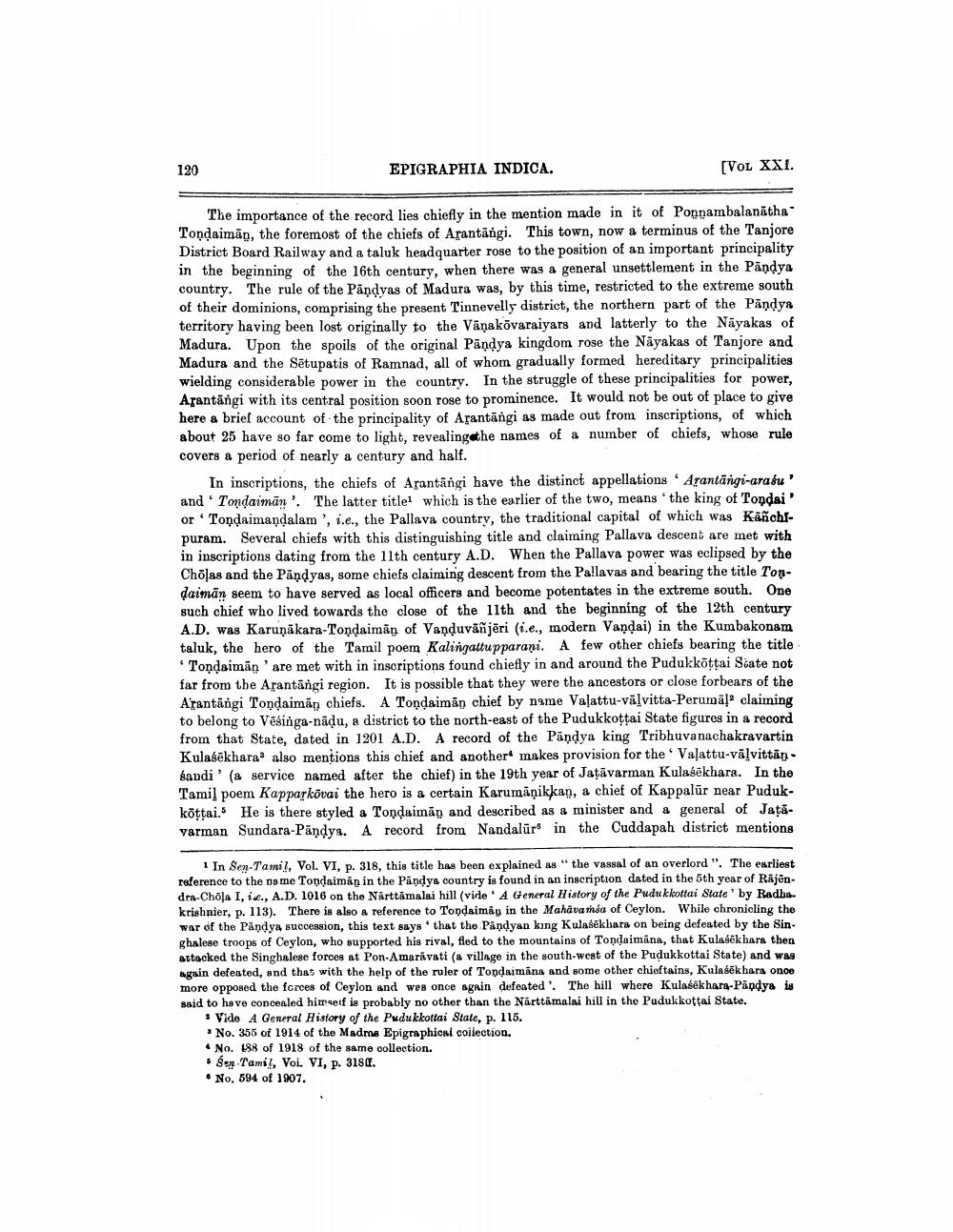________________
120
EPIGRAPHIA INDICA.
[VOL XXI.
The importance of the record lies chiefly in the mention made in it of Ponnambalanātha" Tondaimān, the foremost of the chiefs of Arantāngi. This town, now a terminus of the Tanjore District Board Railway and a taluk headquarter rose to the position of an important principality in the beginning of the 16th century, when there was a general unsettlement in the Pandya country. The rule of the Pāndvas of Madura was, by this time, restricted to the extreme south of their dominions, comprising the present Tinnevelly district, the northern part of the Pandya territory having been lost originally to the Vāņakõvaraiyars and latterly to the Nāyakas of Madura. Upon the spoils of the original Pandya kingdom rose the Nayakas of Tanjore and Madura and the Sētupatis of Ramnad, all of whom gradually formed hereditary principalities wielding considerable power in the country. In the struggle of these principalities for power, Asantāngi with its central position soon rose to prominence. It would not be out of place to give here a brief account of the principality of Asantāngi as made out from inscriptions, of which about 25 have so far come to light, revealingethe names of a number of chiefs, whose rule covers a period of nearly a century and half.
In inscriptions, the chiefs of Arantāngi have the distinct appellations Arantängi-arasu' and Tondaimūn'. The latter title which is the earlier of the two, means the king of Tondai' or 'Toņdaimandalam ', i.e., the Pallava country, the traditional capital of which was Käñchrpuram. Several chiefs with this distinguishing title and claiming Pallava descent are met with in inscriptions dating from the 11th century A.D. When the Pallava power was eclipsed by the Cholas and the Pandyas, some chiefs claiming descent from the Pallavas and bearing the title Tondaimān seem to have served as local officers and become potentates in the extreme south. One such chief who lived towards the close of the 11th and the beginning of the 12th century A.D. was Karunākara-Tondaimān of Vanduvāñjēri (i.e., modern Vandai) in the Kumbakonam taluk, the hero of the Tamil poem Kalingattupparani. A few other chiefs bearing the title * Tondaimān ' are met with in inscriptions found chiefly in and around the Pudukkottai Siate not far from the Arantangi region. It is possible that they were the ancestors or close forbears of the Arantāngi Tondaimán chiefs. A Tondaimán chief by name Vaļattu-vālvitta-Perumā!" claiming to belong to Vēsinga-nādu, a district to the north-east of the Pudukkottai State figures in a record from that State, dated in 1201 A.D. A record of the Pandya king Tribhuvanachakravartin Kulasēkhara' also mentions this chief and another makes provision for the Vaļattu-vālvittänsandi' (a service named after the chief) in the 19th year of Jaţăvarman Kulasēkhara. In the Tamil poem Kapparkövai the hero is a certain Karumāņikkan, a chief of Kappalūr near Pudukkottai. He is there styled a Tondaimān and described as a minister and a general of Jatavarman Sundara-Pandya. A record from Nandalüro in the Cuddapah district mentions
1 In Sen-Tamil, Vol. VI, p. 318, this title has been explained as "the vassal of an overlord". The earliest reference to the name Tondaimán in the Pandya country is found in an inscription dated in the 5th year of Rajondra-Chola I, 12., A.D. 1016 on the Nárttámalai hill (vide. A General History of the Pudukkottai State' by Radha krishnier, p. 113). There is also a reference to Topdaimäg in the Mahavamsa of Ceylon. While chronicling the war of the Påndy succession, this text says that the Pandyan king Kulasekhara on being defeated by the Sin. ghalese troops of Ceylon, who supported his rival, fled to the mountains of Tondaimana, that Kulasekhara then attacked the Singhalese forcos at Pon Amaravati (a village in the south-west of the Pudukkottai State) and was again defeated, and that with the help of the ruler of Tondaimana and some other chieftains. Kulasekhara on more opposed the forces of Ceylon and was once again defeated'. The hill where Kulasekhara-Pandya is said to have concealed himself is probably no other than the Nårttimalai hill in the Pudukkottai State.
1 Vide A General History of the Pudukkottai Stale, p. 115.
No. 355 of 1914 of the Madma Epigraphical collection. No. 188 of 1918 of the same collection. . Sen Tamil, Vol. VI, p. 3184. • No. 594 of 1907.




